Getting a Grip
by Armin Winkler
At my seminars, I like to address specific training issues the dog handlers feel is their dogs' weakest point in protection. I would say that with the dogs who have already had some protection training, the single most mentioned problem is the issue of gripping technique. The most lamented concerns are a shallow bite and "munchy", hectic behavior on the sleeve. Most of the time the cause for this "deficiency" gets placed at the feet of the dog. And, while that may be the case in some instances, it is usually the least prominent cause for the problem. In order to address any problem in training, we need to first and foremost identify where it comes from in the first place.
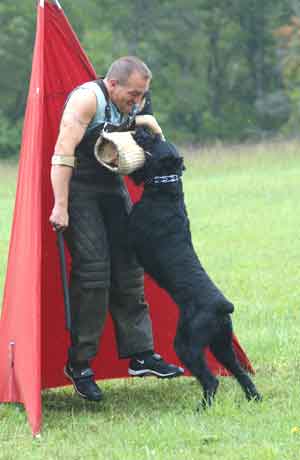 With that said, I am again at a point where I have to explain a bit of my thinking, so that readers know where I come from.
The first premise which needs to be set is this: full, calm, convincing grips are prey motivated.
While defense drive gives us intensity and seriousness, and ultimately a harder bite, if the training is done right, it is an undeniable truth,
that the bite we all want, full and hard and calm, as well as deep mouthed striking at every opportunity, comes from prey, and prey only.
With that said, I am again at a point where I have to explain a bit of my thinking, so that readers know where I come from.
The first premise which needs to be set is this: full, calm, convincing grips are prey motivated.
While defense drive gives us intensity and seriousness, and ultimately a harder bite, if the training is done right, it is an undeniable truth,
that the bite we all want, full and hard and calm, as well as deep mouthed striking at every opportunity, comes from prey, and prey only.
So, where then do the grip problems come from? Well, first have to rule out any kind of physical causes, such as bad teeth, sore jaws, neck problems, etc.. In few cases, they cause the dog to not bite properly.
Once health issues are ruled out, we can start trying to find out what is causing the grip problem. With very few exceptions, grip problems result from the fact that the dog is wrestling with a conflict, which interferes with his ability to deal with his prey (sleeve) in a clear and unbothered fashion.
The most common cause for conflict for the dog during protection work is the conflict between helper and dog. If the dog was purely prey motivated, grip problems really would not be an issue. But something interferes with the dogs ability to concentrate purely on the prey. That something is the threatening influence of the helper. The threat can come from the helper merely being present and the dog perceives him as threatening, or the helper deliberately or unwittingly creates threats for the dog by his actions. In other words, the helper stimulates a defensive motivation in the dog. And as mentioned in a previous article, a defensive motivation is nothing more than the dog's concern for his well-being. So, the dog is interested in the prey (sleeve), and at the same time he is concerned for his welfare. That is the conflict. The dog cannot clearly focus and concentrate on his prey, because he is pre-occupied with another concern. It should be clear to everyone that this has to interfere with the dog's ability to deal just with the prey in a clear way.
The second most common cause is the conflict between handler and his dog. Once again, we have a conflict. The dog is interested in his prey, but something else is also on his mind. In this case it is the handler. The dog cannot concentrate on his prey with single minded focus, because he is distracted. Well meaning handlers, who are so busy encouraging their dog, they get carried away, don't do their dogs any favors. I have encountered handlers who just can't stand still, always fidgeting around behind the dog, others who yell the praise so loud, they startle the dog, others who give completely inappropriate commands, still others, who are clearly overbearing and the dog is clearly worried about the person behind him. The list certainly goes on much longer, but these are a few examples to make the point. Again, it is obvious that a pre-occupation with what the heck the handler is doing behind him can't allow the dog to focus where he should, which is the prey.
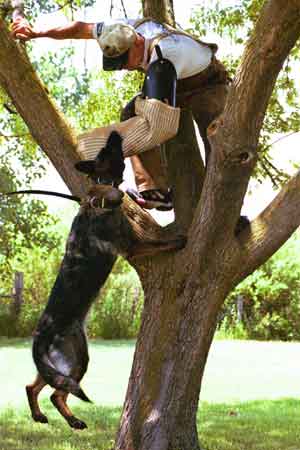 The third reason is directly related to the second one. This is where handler influence during the teaching of an exercise has led to conflict.
In this case, it is quite possible, that the dog and handler have a relatively harmonious relationship, until it comes to certain exercises, or situations
which remind the dog of those exercises. The most common offenders are the "Out" exercise, and the "Hold and Bark" exercise. Letting go of the prized prey,
or not being allowed to make prey (as in the case of the h&b) lead to conflict, period. No matter how good we are as handlers,
interfering with the natural sequence of events, as far as the dog is concerned, will always bother the dog.
I would also like to mention that undue and unfair levels of compulsion during the teaching of these exercises will only add to the conflict.
When a situation reminds the dog of one of those conflict causing exercises, his focus will shift away from the prey and again he is wrestling
with another issue at a time when he should be concentrating on his prey. And grip problems are the result.
The third reason is directly related to the second one. This is where handler influence during the teaching of an exercise has led to conflict.
In this case, it is quite possible, that the dog and handler have a relatively harmonious relationship, until it comes to certain exercises, or situations
which remind the dog of those exercises. The most common offenders are the "Out" exercise, and the "Hold and Bark" exercise. Letting go of the prized prey,
or not being allowed to make prey (as in the case of the h&b) lead to conflict, period. No matter how good we are as handlers,
interfering with the natural sequence of events, as far as the dog is concerned, will always bother the dog.
I would also like to mention that undue and unfair levels of compulsion during the teaching of these exercises will only add to the conflict.
When a situation reminds the dog of one of those conflict causing exercises, his focus will shift away from the prey and again he is wrestling
with another issue at a time when he should be concentrating on his prey. And grip problems are the result.
Next on the list are temperament deficiencies and behavioral problems unrelated to protection work. Whether these problems are genetic, or whether they were caused by human influence is not really relevant at this point. These dogs have problems dealing with many situations in their life, the fact that they can't clearly focus on prey during protection work is no big surprise. Even if their prey drive is good, there are just too many things interfering with a single minded expression of that drive. I have to say though, that with the average dog out of working line dogs this is the least common cause of grip problems.
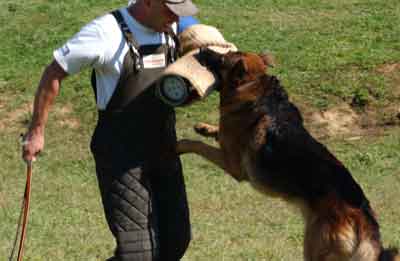 Lastly I have to mention that the helper in protection work is the single most important factor that determines gripping technique.
No matter what the actual cause of the grip deficiency is, the helper should be the first to notice it and then determine the cause.
In some cases not only does the helper not notice anything about the grip until it is too late, but he actually teaches it to the dog.
How does he do that you ask? Well, aside from being the cause of conflict (no matter how subtle), he can also reinforce bad
gripping behavior no matter where it comes from, by rewarding it unwittingly.
Lastly I have to mention that the helper in protection work is the single most important factor that determines gripping technique.
No matter what the actual cause of the grip deficiency is, the helper should be the first to notice it and then determine the cause.
In some cases not only does the helper not notice anything about the grip until it is too late, but he actually teaches it to the dog.
How does he do that you ask? Well, aside from being the cause of conflict (no matter how subtle), he can also reinforce bad
gripping behavior no matter where it comes from, by rewarding it unwittingly.
All right, now that we know where the problems come from, how do we figure out what causes them in the individual dog in front of us, and what do we do to improve the deficiency? I am sure there are many ways, but for now I will try to explain how I go about it.
I want to state a premise once again, to avoid any misunderstanding. The assumption for this discussion is that the dog competently bites at least an intermediate sleeve. The specific problems to address are either shallow biting, poor striking with shallow grips, or "munchy", hectic gripping behavior, or any combination of the above.
When presented with such a dog at a seminar, I do what I do with every dog. I feel him out to get a read of the problem. I do this generally by giving the dog some on leash bites. I prefer to always start with a sleeve one level softer than what the dog is used to biting. The reasons for this are that I can feel much better what is happening with the dog's grip at every moment, and I make sure that the dog is not overwhelmed right from the start, so get a better idea of what the dog is all about. I start with a lot of prey attraction and watch the dog's reaction to that stimulus. The dog gets a couple of run-by bites, with strips, to get him in the mood. Then, he deliberately gets a very shallow bite, this allows me to assess how willing the dog is to re-bite and under what circumstances he will and under which he won't re-grip.
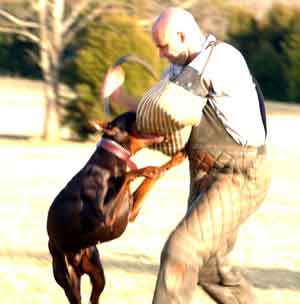 This is already the first place where the causes for bad grips will show up. The dog has a chance to work in prey and win right away,
I try not to present any defense triggering stimuli. If the dog still acts very defensive, for example, very serious barking when all he should
notice is prey attraction, immediate growling on contact with the sleeve, extremely volatile physical maneuvers attempting to get away from
me with the sleeve, shallow biting despite the opportunity to bite full, and no or very slow coming re-gripping behavior, are pretty strong signs
that the conflict at hand is a defense issue (dog vs. helper conflict).
This is already the first place where the causes for bad grips will show up. The dog has a chance to work in prey and win right away,
I try not to present any defense triggering stimuli. If the dog still acts very defensive, for example, very serious barking when all he should
notice is prey attraction, immediate growling on contact with the sleeve, extremely volatile physical maneuvers attempting to get away from
me with the sleeve, shallow biting despite the opportunity to bite full, and no or very slow coming re-gripping behavior, are pretty strong signs
that the conflict at hand is a defense issue (dog vs. helper conflict).
This is also a good chance to observe the handler with the dog. Constant repetition of commands while I try to get the dog to focus on the sleeve, telling the dog to bark at me, while I try to get the dog to target and get ready to bite, or the "overambitious father" gesturing, where the handler thinks the louder he yells, the more talent the dog gets, are very obvious signs of a handler -dog conflict. How clumsy the handler deals with the dog when the dog has the sleeve, how the dog reacts to praise from the handler while having the sleeve, and how the handler takes the sleeve from the dog to prepare for the next bite, are ways to observe how much harmony or dis-harmony exists between them.
If one of those two conflicts is already noticeable at this stage, I want to explore my initial hunches a bit further. First, to discuss the defense related (helper - dog) conflict. I will now work on getting a good bite from the dog. If the mere sight of me is enough to stimulate defensive behavior, I have to remove that stimulus. Remember the principle is to make the dog think prey and nothing else. I use a puppy tug on a leash to see if I can get the dog to forget all about me for a moment. What I am looking for here is that the dog noticeably concentrates on the object and not on me. Swinging the tug on the leash, with minimal body movements, then making it land on the ground and beside the dog and even behind him a bit allow me to see if the dog is willing to take his eyes off me and pay attention just to the object. Once I notice that type of behavior, I offer an opportunity to bite. Generally the bite is calmer at this point, the leash allows a fair bit of distance between the helper (the defensive stimulus) and the prey, so I can get the dog to re-grip by just relaxing the situation. When the dog shows the calmer grip and re-grip on this easy to bite prey-object, when at a certain distance from the threat, the evidence is fairly clear that the root (at least one of them) for poor grip behavior is a defense related conflict. I can achieve the same scenario by putting a sleeve on a leash and swinging it, or I can offer the dog bites only with my back turned, and never facing the dog acting very weak and non-threatening. I hope that the reader gets the idea here, depending on the level of the dog's sensitivity, I have to remove all defensive stimuli in order to assess the dog's biting in prey drive. As a reminder, defensive stimuli are: Staring, frontal confrontation, threatening hand gestures, stick threats, picking the dog up off the ground (even just his front legs), hard sleeves. Anything that gives the impression to the dog that the helper is something to worry about. I want to address dogs who are more advanced in their training with the same problem. The dog bites calm on a run-by's, but as soon as I face the dog frontally the dog's grip gets busy. Or as long as there is movement before the bite, the dog always bites full, but as soon as he gets no movement and some staring, the dog takes a noticeable shallower bite. All those are very strong indications that the dog is dealing with a helper - dog conflict which he has not yet learned to conquer.
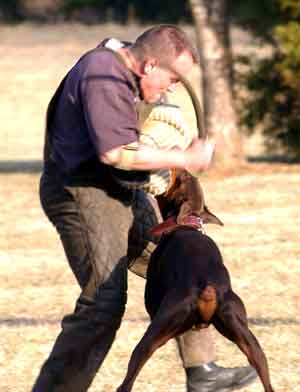 Next, let's explore how we can tell whether we are dealing with a handler - dog conflict. One sign that should be very obvious is a dog who
constantly flicks his ears back, or rolls his eyes, to try and keep tabs on the handler at all times. Dog who completely turn away from the action the
helper is trying to create when the handler makes himself noticeable. Dogs who stand very uncomfortable while the handler is praising. Dogs who
squirm away when the handler is petting them. Dogs who either drop the sleeve like a hot potato when the handler touches them, or dogs who fight
with the handler over the sleeve. All of the above would make me speculate that the problem causing conflict is handler - dog dis-harmony. So now we
have to test out that theory. So again, we try to remove the influence which causes the conflict as much as possible. The handler is given strict instructions
not to move around at all, not to say anything, to just hold the leash at one length and let the helper work the tension. Next, we try to remove all other things
where the handler is a big factor, running with the sleeve is reduced to letting the dog circle around the handler once, like a horse on a longe line. Then the
dog is reeled in, held by the collar, the handler steps on the sleeve, and pulls steady up on the collar with no other influence until the dog slips off the sleeve.
With the same matter of fact attitude, the sleeve is kicked back to the helper, or the handler walks away with his dog, whichever causes less difficulty
for the handler. The helper begins his prey attraction again.
Next, let's explore how we can tell whether we are dealing with a handler - dog conflict. One sign that should be very obvious is a dog who
constantly flicks his ears back, or rolls his eyes, to try and keep tabs on the handler at all times. Dog who completely turn away from the action the
helper is trying to create when the handler makes himself noticeable. Dogs who stand very uncomfortable while the handler is praising. Dogs who
squirm away when the handler is petting them. Dogs who either drop the sleeve like a hot potato when the handler touches them, or dogs who fight
with the handler over the sleeve. All of the above would make me speculate that the problem causing conflict is handler - dog dis-harmony. So now we
have to test out that theory. So again, we try to remove the influence which causes the conflict as much as possible. The handler is given strict instructions
not to move around at all, not to say anything, to just hold the leash at one length and let the helper work the tension. Next, we try to remove all other things
where the handler is a big factor, running with the sleeve is reduced to letting the dog circle around the handler once, like a horse on a longe line. Then the
dog is reeled in, held by the collar, the handler steps on the sleeve, and pulls steady up on the collar with no other influence until the dog slips off the sleeve.
With the same matter of fact attitude, the sleeve is kicked back to the helper, or the handler walks away with his dog, whichever causes less difficulty
for the handler. The helper begins his prey attraction again.
Within a few repetitions of this, the dog should be able to concentrate on what we want him to concentrate on, the sleeve, nothing else. If we see noticeable improvements in gripping technique, we have again found the culprit. Briefly on more advanced dogs. The fact that the dogs advanced means that the dog is obviously able to deal with a certain amount of handler interference without showing great effects. With those dogs I experiment with a few different things. For example, I have the handler place his dog in a down position and do a run away bite. Comparing the easy warm-up bite pressure and intensity to the first bite after having to lie down tells us a lot about how much drive the handler takes from his dog because of his influence. Another exercise is to make the dog heel for a bit, then send him for a bite. Compare that to just holding the dog and letting go of the collar when the helper signals. Let the dog bite, walk him away from the handler (leash gets dropped), and then walk back to the handler with the dog. All these are fact finding bites, which need to be compared to each other to determine whether or not the handler is the cause of the conflict. I would say that after doing what I just described an experienced helper should be able to determine if the handler plays a role in the conflict.
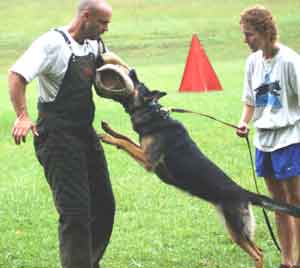 The handler can hurt the dog in another way, namely the combination of defense coupled with handler conflict. To determine whether this is the case is
fairly straight forward if the reader understands the first two situation. Test the dog with no handler influence and no defense stimulus, then handler influence
still no defense influence, then no handler influence with defense stimulus, and then both handler influence plus defense stimulus. Compare all these against
each other and make an assessment. Of course the handler influence has to be enough of an influence that the dog shows a reaction (even a slight one) to it.
The same goes for the defense stimulus, it has to be a stimulus the dog actually shows a defensive reaction to. It often happens that a dog can handle recovering
from handler influence in a split second and respond to a prey stimulus. But handler influence makes them incapable of dealing with defensive stimuli.
The handler can hurt the dog in another way, namely the combination of defense coupled with handler conflict. To determine whether this is the case is
fairly straight forward if the reader understands the first two situation. Test the dog with no handler influence and no defense stimulus, then handler influence
still no defense influence, then no handler influence with defense stimulus, and then both handler influence plus defense stimulus. Compare all these against
each other and make an assessment. Of course the handler influence has to be enough of an influence that the dog shows a reaction (even a slight one) to it.
The same goes for the defense stimulus, it has to be a stimulus the dog actually shows a defensive reaction to. It often happens that a dog can handle recovering
from handler influence in a split second and respond to a prey stimulus. But handler influence makes them incapable of dealing with defensive stimuli.
The last conflict to discuss is the one caused through the teaching of exercises. In this case the bites are usually good, except in some situations. If the suspicion is then that the dog is experiencing a conflict because he anticipates having to do something he does not want to do, then we again have to explore this hypothesis. Let's say the dog bites good and does not seem to show a particular difficulty with defensive stimuli, then, when the helper's movements slow down, he gets busy or changes his grip from good to more shallow. The same thing happens if the handler steps up to praise the dog, or when the helper takes the dog back to the handler. My suspicion would be the dog feels conflicted when he anticipates an "Out". I would give the dog a run away bite no threat, pull the dog into the typical frontal out position, and tell the handler to give the out command from a short distance away. One of two things will happen. One, the dog starts acting totally uptight, the grip goes to pieces in seconds, and the dog frantically chews around on the sleeve. It does not take a brain surgeon to figure out that that means the dog does not want to let go, but knows there is trouble if he doesn't. And there is our conflict. The other case is this, the dog outs nice and clean. Now what? Were we wrong? Not necessarily. Give the dog another bite, without a lot of stimulation. What do we notice there? Often the bite is now shallow, or it is weaker, or the targeting is poor. If the dog does a hold and bark after the out, the bark is a good indication of how clear headed the dog is in this position. Generally very a-rhythmic and stuttery barks are signs of conflict the dog does not know how to deal with. Again these are the things which should give us confirmation whether or not the "out" exercise is the cause of the conflict. With the hold and bark exercise as the culprit the situation is relatively simple. How well does the dog bark? And how does he bite from the hold and bark, compared to just run by bites?
Naturally we have to also realize that not just the exercises cause this conflict, but everything that may remind the dog of the exercise. For example, the handler approaching, the helper freezing, the blind, any backstop, anything that the training team (handler and helper) did when the exercises were taught, so search your brains. Some dogs never wear a prong collar during protection, only when working on outs or hold and barks. That is enough to cause bad grips whenever the prong collar is on in some dogs.
There is no point in discussing the other situations. Dogs which have temperament or serious behavioral problems, either genetic or learned, need help with those problems long before they should ever do any protection work. And lets hope that the helpers who don't notice that a dog is chewing on the sleeve while they have it on are a dying breed.
Now a brief discussion on how to rectify or at least improve the grip problems caused by the above mentioned conflicts. With the first two causes, the situation is virtually identical. First we have to explore how to get good bites from the dog in question where no conflict exists. I mentioned a variety of ways to do that earlier, so I won't bore people by regurgitating them here. Here is a good rule of thumb. If a dog bites nicely on toys or when they play , then there has to be a way to get them to bite like that in protection. So first we have to find a way to get the desirable bite. There are no limits to a helpers imagination either, whatever works. If I have to go back to a sack, then so be it. A stuffed animal does the trick, fine. If I have to run, then I run until I can't run anymore. And if standing still and swinging something on a rope is required then that is what I do. In order to get a dog to bite a certain way, I have to figure out what makes him want to bite that way. When I have determined how I can get full mouthed calm bites, with decisive re-gripping behavior, then I can start to slowly present the dog with the stimuli which cause the conflict. Then when I see the slightest reaction to that stimulus, I remove it and allow the dog to refocus on what makes him bite well. For example, if defensive stimuli cause the conflict, then I get the dog biting the sleeve (it could be just a tug too) just in prey. When I see the bite is good, I start again with prey attractions, then mix a low level threat into the action, if I hear the slightest bark change, or a less concentrated focus on the sleeve, I work on re-focusing him on the prey, and allow a bite. Eventually, the threatening happens during the bite, then the prey attraction has to trigger the re-grip. I discussed this already in previous articles under countering and channeling defense behavior to prey drive. A dog who has learned to actively counter defensive stimuli and who can channel from defense behavior into prey drive will not show the grip problems we are talking about here. So basically one has to go back to teaching some foundation.
The handler conflict work is similar, figure out how to take the handler out of the picture enough to get good bites, then slowly let the handler get more involved. But the dog has to dictate at what pace that occurs. Then teach better handling, explain what about his handling is causing conflict, and how to avoid those things. The dogs grip initially as well as the confidence in the re-grip during the biting are again the gages for what is working. General team building exercises will help as well, but it would lead too far astray to describe them here.
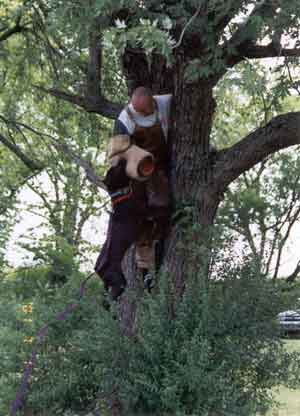 I promised I would discuss problems with striking in this article. Well, I kind of have. The biggest cause for poor striking, and poor grips on the
strike are the above two conflicts and a combination of the two. Dogs who don't strike well frontally, but almost knock you flat on a run away, with
the sleeve shoved as far back in their mouth as they can, have a difficulty changing gears. They feel threatened by the frontal helper, and have not
yet learned to channel from that defensive feeling into prey drive. So as helpers, we have to show them, by presenting a prey stimulus (run away)
to get a good strike and bite. Then we gradually help them less and less while presenting more and more threat.
The handler influence conflict rears its ugly head here as well. So, again we make the handler as neutral as necessary to get the good bite,
and then gradually involve the handler more and more, until we have him involved as much as he has to be for trial and training purposes.
I promised I would discuss problems with striking in this article. Well, I kind of have. The biggest cause for poor striking, and poor grips on the
strike are the above two conflicts and a combination of the two. Dogs who don't strike well frontally, but almost knock you flat on a run away, with
the sleeve shoved as far back in their mouth as they can, have a difficulty changing gears. They feel threatened by the frontal helper, and have not
yet learned to channel from that defensive feeling into prey drive. So as helpers, we have to show them, by presenting a prey stimulus (run away)
to get a good strike and bite. Then we gradually help them less and less while presenting more and more threat.
The handler influence conflict rears its ugly head here as well. So, again we make the handler as neutral as necessary to get the good bite,
and then gradually involve the handler more and more, until we have him involved as much as he has to be for trial and training purposes.
The exercise related conflicts are fairly straight forward as well. First stay away from the exercises which cause the conflict until there are no more reminder conflicts, ie. when the handler approaches. Then every once in a while put one of the exercises in the mix and make sure the dog comes out of the "conflict hole" all the way before doing it again. As an example, I had a dog in my club, who had a lot of baggage from previous training. He got himself into knots during hold and barks. He was whiny and stressed, and his bites suffered tremendously. But we could not just not do hold and barks. So for every hold and bark I did about 6 or more long pursuits. The dog had very good prey drive, so the running and striking helped him get his feet back on the ground. But it stands to reason, that one or two hold and barks were the dog's absolute maximum. He made good improvements, has a SchH1 and is on the way to a 2.
In conclusion, I want to remind people. The dogs are the biggest part of this sport, they determine the speed of progress, and they ultimately also determine the training methodology. If a dog can grip well but does not always do it, then it is us humans who are doing something wrong. Dogs need to have things taught to them. We present them with problems in protection work and don't take the time to teach them how to solve them. Grip behavior is a very good indication of that. We can't always avoid doing things which cause grip problems, but as we all know, grips are judged in trials, and they should be judged in training as well, so we better make sure we help the dogs get back to where they work as well as they can. Isn't that what training is all about?
Finally a short word of acknowledgement. My friend, Thomas Baumann has summarized pretty much the same root causes for grip problems as I have listed here in his book "Neue Wege der Polizeihundeausbildung". As trainers we are all products of our experiences. I'd like to think that I come up with my own ideas, but reading books and discussions inevitably shape our way of thinking. And since Thomas wrote his book before I wrote this article, I want to share the credit with him.
